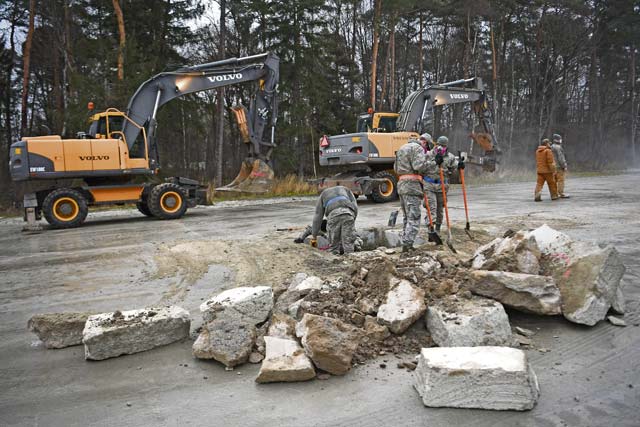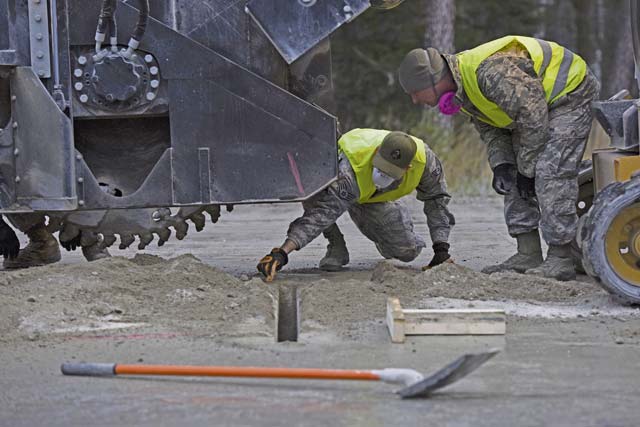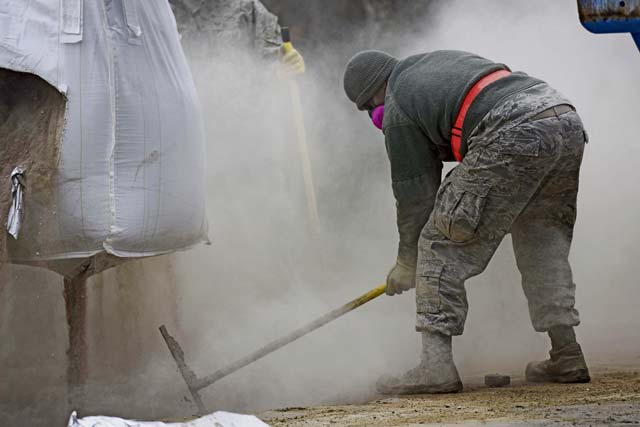
The 435th Construction and Training Squadron training flight innovated how they train Airmen with the newly modernized process to repair damaged aircraft runways in more efficient ways, in less time.
435th CTS training flight Airmen are now training civil engineer Airmen through the Rapid Airfield Damage Repair training course which replaces the outdated Airfield Damage Repair course. Airmen from across the Air Force will travel to Ramstein to attend the training.
RADR encompasses all actions required to rapidly repair runways and runway support structures to recover operations on an airfield after an attack. RADR may be conducted during conditions such as inclement weather, chemical, biological, radiological, and degraded environments.
“The instructors took all of us random career fields within the civil engineer career field and implemented this dirt boys mentality, it’s a lot of dirt boy specific jobs that other career fields were doing,” said Tech. Sgt. Patrick Brooks, 611th Civil Engineer Squadron pavements and equipment noncommissioned officer in charge.
Some of the teams involved in the process include the debris removal, pavement, breaker, excavation, and fill teams. Civil engineer Airmen fulfil predesignated roles and teams based on career field. Most of the Airmen involved can play multiple roles as needed during the repair.
RADR capability requires multiple critical tasks be accomplished with seamless integration. These are often accomplished within overlapping and simultaneous timeframes.
“For the Airmen, the hardest part I think initially was just shock,” said Brooks. “We were asking an airman 1st class from the plumbers shop to drive a piece of heavy equipment. But when they started learning how to drive it, I think the younger guys were really enjoying it.”
As part of the training, the 435th CTS trainers subject the students to a simulated enemy attack on the airfield. The explosive ordnance disposal team clears the airfield of any unexploded ordnance, and the debris removal team clears the areas around the craters. Then two pavement teams begin cutting through the runway tarmac. The pavement teams then jump to the next crater and continue cutting until they accomplished their part of the mission.
“This new system is like a dance, there are a lot of parts,” said 2nd Lt. Emily Steele, 611th Civil Engineer Squadron chief of project management, and RADR course student. “It’s almost like a factory process.”
After the pavement team makes their way down the runway, the breaker team and excavation team come through and clear out the holes in the runway. Airmen then verify the depth of the hole and the warehouse and fill teams begin to fill the holes. Teams of Airmen mix the flowable fill cement and cap it with quick-drying cement, or asphalt. With this process, the team is able to fill 120 craters in six-and-a-half hours in perfect conditions.

The training course is five-days long and gives Airmen time to learn the controls to their equipment.
“They progressed in a walk, crawl, and run and displayed proficiency level as intended,” said Master Sgt. Kyle Warnock, 435th CTS heavy repair contingency training section chief. “The second day they practiced completing the repair of three craters. By the fourth day of training they completed six craters faster than it took them to complete three on the second day.”
To wrap up the training course, Airmen completed a full-length training exercise on a section of taxiway on Ramstein Air Base.
“People were definitely pushed outside their comfort zone having to learn things they never learned before,” said Steele. “It wasn’t hard to learn, but it was important having a week to practice, where multiple days were spent learning how to drive the equipment. At the end of the day, we had the majority of the job done in about four hours and it showed the Airmen got the training they needed.”
With the highest levels of Air Force leadership identifying the gap in capabilities, the new training process was put in place to counter the emerging threat of enemy attacks. Due to the leadership directive, all civil engineer Airmen are required to attend the training course.
“Leaving here, I think we all have the skills to be able to execute, and it is just a matter of maintaining those skills from now on,” said Steele.



